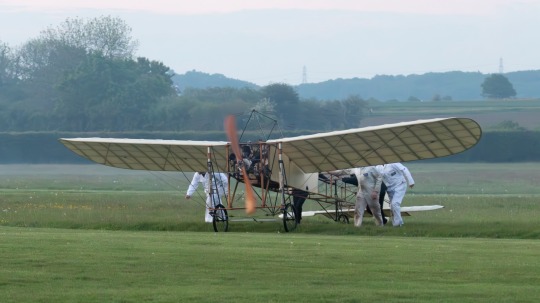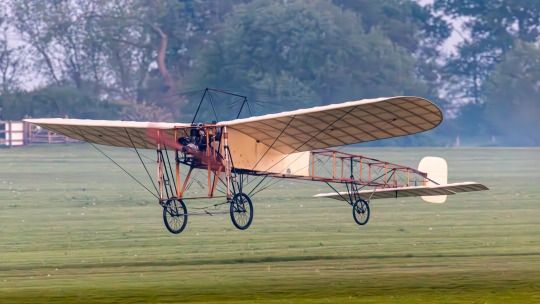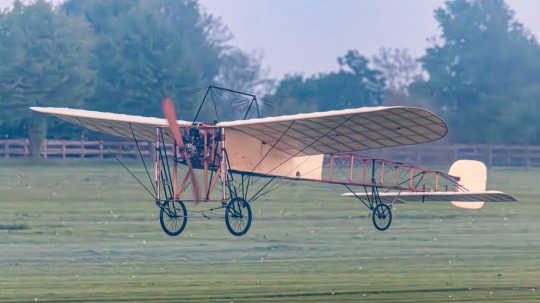#blériot type XI
Explore tagged Tumblr posts
Text
The oldest airworthy, and still flying, aircraft and engine in the world.
Blériot Type XI No. 14, G-AANG, with its Anzani three-cylinder W Engine, at The Shuttleworth Collection, Old Warden.
One of the ‘Edwardians’, this 114 year old plane occasionally makes small hops down the runway on especially calm summer evenings.




Taken by @the-man-in-the-wind
110 notes
·
View notes
Text
Dark Aircraft...

Dark Blériot Type XI.
Dark aircraft have a long and hallowed history stretching back to the dawn of aviation.
(actually it is just an excuse for me to post these cool aircraft silhouette images.)
14 notes
·
View notes
Text
Roland Garros není jen tenis
V nadcházejících týdnech určitě hodně uslyšíte o #RolandGarros, ale věděli jste, že spíše než ničivý forhend nebo hedvábný jednoručný bekhend to byla jeho oslnivá kariéra letce, která zapsala jeho jméno do historie?

Garros se narodil 6. října 1888 v Saint-Denis de La Réunion.

Historie neuvádí, v kolika letech odpálil svůj první míč, ale právě když se v roce 1909 během dovolené v kontinentální Francii zúčastnil Grande Semaine d'Aviation de la Champagne, projevila se u tohoto sportovního nadšence vášeň pro letectví.

19. července 1910 získal Roland Garros pilotní průkaz č. 147 od Aéro-Club de France na letišti Cholet (Maine-et-Loire). Byl to začátek jeho výjimečné letecké kariéry. Během osmi let vytvořil řadu rekordů a vyzkoušel a zdokonalil několik generací letadel.

Po získání pilotního průkazu odletěl Roland Garros do Spojených států, kde se zúčastnil mnoha leteckých přehlídek ve své "Demoiselle", vynálezu firmy Santos-Dumont. Za Atlantikem si pro svou obratnost a odvahu vysloužil přezdívku "Cloud Kisser".

Roland Garros s pilotováním letounu Blériot XI zúčastnil tří významných závodů v roce 1911: leteckého závodu Paříž-Madrid, který vyhrál Jules Védrines, závodu Paříž-Řím-Turín a Evropského okruhu, který dokončil na 2. místě s celkovým časem 62 h 17 min 16 s.

17. června 1912 vyhrál Roland Garros po dvoudenní soutěži Velkou cenu Aéro-Club de France, která se konala v Angers. Dne 6. září téhož roku odstartoval z pláže v Houlgate (Calvados) a vytvořil nový výškový rekord, kdy vystoupal do 4 950 m.

Dávno před homérskými souboji #Nadal, #Federer a #Djokovič je jméno Rolanda Garrose spojeno s jiným zápasem ve vysokém letu: s tím, který 8. června 1912 svedl s Edmondem Audemarsem, jenž vyhrál jejich závod na 50 km a 2 rychlostní závody ve stoupání a přistání.

Dne 23. září 1913 dosáhl Roland Garros svého nejvýznamnějšího úspěchu: za 8 hodin a v dantesovských letových podmínkách se mu podařilo z Fréjus doletět do Bizerte v Tunisku a uskutečnit tak první letecký přelet Středozemního moře na palubě letounu Morane-Saulnier Type H.

V dubnu 1914 vyhrál Roland Garros se svým letounem Morane-Saulnier No. 5 Monackou leteckou rallye - 1 140 km dlouhý okruh napříč Evropou, včetně 210 km dlouhé námořní trasy mezi Marseille, Janovem a Monakem, na kterou byly přihlášené letouny vybaveny plováky.

Jako dobrovolník ve Velké válce (První světové válce) získal #RolandGarros povolení k vývoji vynálezu inženýra Raymonda Saulniera: pevný kulomet umístěný v ose letadla, mezi pilotem a vrtulí.

Roland Garros, vybavený tímto revolučním systémem střelby přes vrtuli, dosáhl před svým sestřelením 3 certifikovaných vzdušných vítězství. Po třech letech věznění se mu podařilo v přestrojení za německého důstojníka uprchnout z Magdeburgu a vrátit se do Francie.

Při návratu do Escadrille 26 byl Roland Garros 5. října 1918 v předvečer svých 30. narozenin sestřelen ve Spadu XIII u Saint-Morel v Ardenách. Zmizel jen několik týdnů před uzavřením příměří 11. listopadu 1918.

Krátce po svém útěku byl Roland Garros 6. března 1918 před zraky své eskadry vyznamenán Řádem čestné legie.

K uctění jeho památky byl v roce 1927 po něm pojmenován tenisový stadion postavený v Porte d'Auteuil, který od té doby hostí French Open.
Zdroj ⬇️
1 note
·
View note
Video
Replica trio - Caudron G.III, Blériot XI ² “Pégoud” & Morane-Saulnier Type H ‘.7’ by Alan Wilson Via Flickr: The Caudron, leading, is registered F-AZMB. It was built in 1991 with the c/n SA-33 and represents a 1914 design. The Blériot, centre, represents the 1910 military variant of the famous XI. It was built in 1990 with the c/n SA-29 and is registered F-AZPG. The Morane, trailing, represents a 1912 design and was built in 1988 with the c/n SAMS 22-01 and registration F-AZMS. These three are the stars of the Salis collection and are seen during their display at the 2019 Fête Aérienne Le Temps Des helices (Aerial Festival – The Time of the Propellers). Aérodrome de Cerny-La-Ferté-Alais, Cerny, France 9th June 2019
10 notes
·
View notes
Text
Replica Zenith Watches for New Collectors
New Replica Zenith Watch is best known as the creator of the El Primero – an integrated, automatic chronograph movement that has earned a place in the pantheon of historic calibers. Today, the brand is also known and appreciated for offering classically styled timepieces and excellent value. Here are five Zenith watches* that we can recommend for new collectors.
Replica Zenith Pilot Type 20 Extra Special
Zenith timepieces accompanied aviators during several early, historic flights. One went with Louis Blériot in July 1909 when he made the first flight across the English Channel in an airplane he built, known as the Blériot XI. One year later, Léon Morane wore a Zenith when he became the first pilot to fly faster than 100 km/hour, also in a Blériot XI. And when the French Air Force geared up for WWII in 1939, it chose Zenith’s Montre d’Aéronef Type 20 for its aircraft instrument panels.
The modern Pilot Type 20 Extra Special captures the look of those early aviation watches. Every aspect of the dial is perfectly proportioned. The stylized Arabic numerals and the substantial cathedral hands, each wearing a generous coating of SuperLuminova, assure excellent legibility in all conditions.
The 45 mm case and oversize crown capture the essence of the early pilots’ watches, as does the oiled Nubuck leather strap with white stitching. The caseback is engraved with the elaborate Zenith Flying Instruments logo. To keep the price accessible, this watch is powered by an automatic, Swiss-made movement provided to Zenith by an outside supplier. (The remainder of our suggested watches feature Zenith manufacture calibers).
Fake Zenith Captain Power Reserve
Zenith’s Captain line debuted in 1952, and the current models adopt aesthetic cues from the brand’s historical models. Our featured watch, the Captain Power Reserve, also represents a step up into the world of Zenith manufacture movements.
The look is simple and elegant, with classic dauphine hands pointing to applied, faceted hour markers. We like the subtle railroad track at the dial’s edge, complete with small Roman numerals. The retrograde Réserve de Marche display at 2 o’clock tracks the mainspring’s 50-hour power reserve.
The case measures 40 mm x 9.25 mm. Zenith’s in-house caliber Elite 685 with automatic winding is visible through the sapphire caseback. This movement contains 179 components and runs in 38 jewels at 28,800 vph. An alligator strap with a pin buckle completes the package.
Copy Zenith Pilot Big Date Special
Our final three featured watches take us into the realm of Zenith’s iconic El Primero-powered chronographs. The vintage-inspired Pilot Big Date Special provides classic good looks with a 42-mm case and rectangular pushers flanking a slightly oversize crown. The dial offers a well-balanced bi-compax layout with continuous seconds at 9 o’clock and a 30-minute counter at 3 o’clock. This look harks back to the chronographs Zenith supplied to the Italian Air Force during the 1960’s, though those watch did not have a date display at 6 o’clock.
The telemeter scale at the dial’s edge creates a technical aesthetic. The double-digit big date display at 6 o’clock really sets this watch apart. The window-filling numerals make the date display pop. All of the displays are crystal-clear, as they should be on a pilots’ chronograph.
Under the dial is the renowned El Primero 4010 automatic-winding caliber with 306 components. It famously runs at 36,000 vph in 31 jewels with a 50-hour power reserve.
Replica Zenith El Primero Original 1969
Our next featured watch carries a name that tells you everything you need to know about it. This new model pays tribute to the original El Primero chronograph, launched in, you guessed it, 1969. That’s the year Neil Armstrong took one small step, Woodstock rocked upstate New York, and the first communications were sent through the ARPANET.
Returning to the present day, this new model features the unmistakable design codes of the original El Primero. The 38-mm case also takes us back in time. The movement is the El Primero caliber 400 with 278 components running at 36,000 vph, or 5 Hz. This is the “magic frequency” for chronographs, because it allows events to be timed to the nearest tenth of a second. This fast rate means the escapement ticks 864,000 times per day, or 315,360,000 per year.
Replica El Primero 36,000 VpH
If you like the classic El Primero tri-compax look but prefer a larger case, Zenith has you covered. This model offers the classic design cues of the originals – oversize, overlapping registers, bold hands, hour markers and minutes chapter, and a tachymeter scale, all in a 42-mm case designed to suit today’s tastes. The increased size results in a more balanced, symmetrical look. The hour markers at 3 and 9 are not cut off, and the enlarged date display moves to 6 o’clock.
In this iteration, the Caliber 400 El Primero movement has 326 components, and of course it still beats at 36,000 vph. The chronograph registers count 30 minutes at 3 o’clock, and 12 hours at 6 o’clock.
0 notes
Video
Replica trio - Caudron G.III, Blériot XI ² “Pégoud” & Morane-Saulnier Type H ‘.7’ by Alan Wilson Via Flickr: The Caudron, leading, is registered F-AZMB. It was built in 1991 with the c/n SA-33 and represents a 1914 design. The Blériot, centre, represents the 1910 military variant of the famous XI. It was built in 1990 with the c/n SA-29 and is registered F-AZPG. The Morane, trailing, represents a 1912 design and was built in 1988 with the c/n SAMS 22-01 and registration F-AZMS. These three are the stars of the Salis collection and are seen during their display at the 2019 Fête Aérienne Le Temps Des helices (Aerial Festival – The Time of the Propellers). Aérodrome de Cerny-La-Ferté-Alais, Cerny, France 9th June 2019
0 notes
Video
1914 Blériot XI ‘340 / 3’ “DOMENJOZ” by Alan Wilson Via Flickr: Although the type is famous for its use in Louis Blériot’s first crossing of the English Channel in 1909, this genuine example was built in 1914 and was powered by a 7-cylinder Gnôme rotary engine. It was purchased by Swiss pilot John Domenjoz who was a flight instructor for the Blériot company and a well known display pilot. He carried out tours of Europe and the Americas but after his final US tour in 1919 the aeroplane was stored in Long Island. It was later sold to a local museum where it remained until sold to the Smithsonian Institution in 1950. It was restored 1979 and is seen on display as part of the ‘Early Flight’ exhibition (Gallery 107) National Air and Space Museum, Washington D.C. 14th March 2018
1 note
·
View note
Text

Blériot type XI ~ The oldest flying airframe/engine combination in the world.
Taken by: @the-man-in-the-wind Old Warden 18th May, 2019
1 note
·
View note
Video
Bleriot Type XI-2, Musee de l'Air, Le Bourget, 05-06-2022 by Gordon Riley Via Flickr: Produced in series, the Blériot XI-2 is a two-seater evolution of the type XI with which Louis Blériot crossed the Channel in 1909. Figure of the pre-war air shows, Adolphe Pégoud realizes in 1913, at the controls of an XI-2 with a reinforced structure, a then sensational acrobatics: the looping. The specimen exhibited, bearing the number 686, belonged to him.
0 notes
Video
1914 Blériot XI ‘340 / 3’ “DOMENJOZ” by Alan Wilson Via Flickr: Although the type is famous for its use in Louis Blériot’s first crossing of the English Channel in 1909, this genuine example was built in 1914 and was powered by a 7-cylinder Gnôme rotary engine. It was purchased by Swiss pilot John Domenjoz who was a flight instructor for the Blériot company and a well known display pilot. He carried out tours of Europe and the Americas but after his final US tour in 1919 the aeroplane was stored in Long Island. It was later sold to a local museum where it remained until sold to the Smithsonian Institution in 1950. It was restored 1979 and is seen on display as part of the ‘Early Flight’ exhibition (Gallery 107) National Air and Space Museum, Washington D.C. 11th May 2015
0 notes
Video
The second monoplane of Pierre Barillon [France, 1909] by Kees Kort Via Flickr: Pierre Barillon built several monoplanes. This is the second design dating from 1909. As the picture shows Barrillon had quite some influeneces in his design. The wings and the control system for the pilot - wheels - seem to come directly from the Antoinette. The landing gear was very similar to the Blériot XI undercarriage (heavily patented by Blériot) differing only somewhat in a central ski and perforated beams pivoting to hold the wheels. The wing had no ailerons and used (just as in some Antoinette types) wing warping.Engine was only 25 hp, a 2-cylinder type. Pierre Barillon got his flying licence of the Aeroclub de France on 7 December 1910 and finally became chief test pilot for Nieuport. Unfortunately he died young from typhoid on 30 August 1912.
1 note
·
View note



